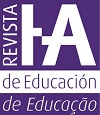Intertextualidad y desarrollo de competencias comunicativas y narrativas
DOI:
https://doi.org/10.35362/rie6031303Palavras-chave:
Intertextualidad, narraciones, discusión, lectura, Educación BásicaResumo
Actualmente los niños están expuestos a diferentes tipos de mensajes, provocando que la alfabetización deba ampliarse a otros ámbitos, como el audiovisual. Por este motivo, uno de los elementos a considerar en la alfabetización es el desarrollo de la competencia intertextual. La premisa es que la intertextualidad ayuda a la construcción de redes de sentido para que los sujetos signifiquen y resignifiquen los textos escritos o audiovisuales que leen. Esta lectura no sólo incrementará la producción cultural, sino que permitirá realizar inferencias, ampliar los matices de la comprensión y desarrollar estrategias para la producción creativa de textos. Este proceso de trabajo puede implementarse transversalmente en el currículum, siendo clave la manera en que el niño adquiere el capital cultural, tanto en su entorno familiar, en su barrio, o en la escuela, ya que éste es una mediación importante para que las estrategias escolares se construyan y tengan mejores resultados.
Downloads
Como Citar
Downloads
Publicado
Edição
Secção
Licença
Os(as) autores(as) que publiquem nesta revista concordam com os seguintes termos:















